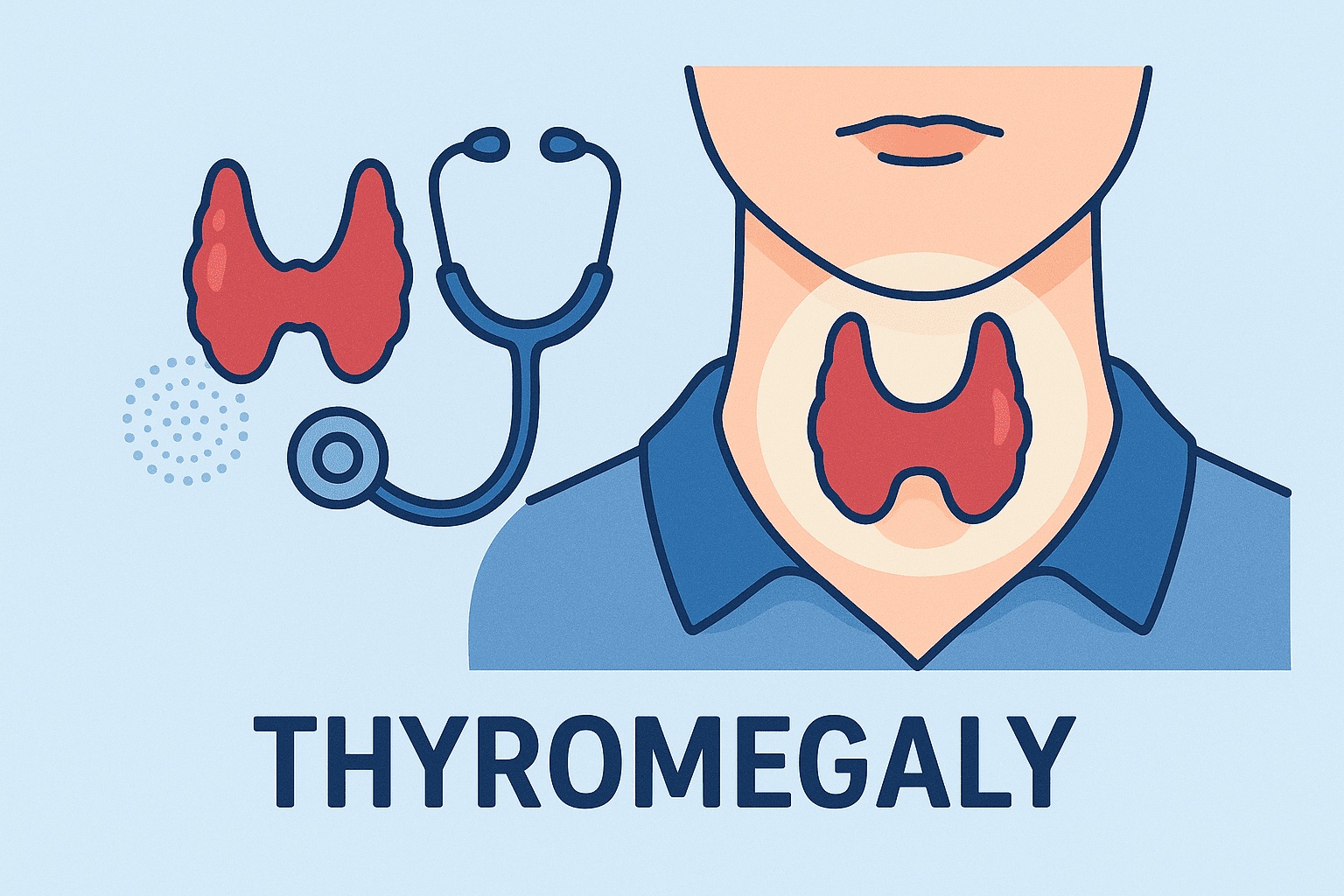Updated on: July 30, 2025
Thyromegaly, or enlargement of the thyroid gland, is a common clinical finding that often presents subtly but may point to significant underlying endocrine disorders. Whether caused by iodine deficiency, autoimmune conditions, or thyroid nodules, accurate evaluation and documentation of thyromegaly are essential for ensuring proper diagnosis, follow-up, and treatment.
In this guide, we’ll explore:
-
What thyromegaly is and how it presents
-
Clinical causes and red flags
-
Proper ICD-10 coding, including E04.9
-
Documentation best practices for thyroid exams
-
How DocScrib simplifies endocrine documentation for busy providers
What Is Thyromegaly?
Thyromegaly refers to an enlarged thyroid gland, regardless of whether thyroid hormone levels are normal (euthyroid), elevated (hyperthyroid), or low (hypothyroid). The term is often used interchangeably with goiter, although “goiter” may refer to more specific pathologies or patterns of enlargement.
📍 Key difference:
Thyromegaly = descriptive clinical term for thyroid enlargement
Goiter = pathological diagnosis often documented and coded more specifically
Common Causes of Thyromegaly
| Category | Etiologies |
|---|---|
| Iodine deficiency | Endemic goiter (still prevalent in some regions) |
| Autoimmune | Hashimoto’s thyroiditis, Graves’ disease |
| Neoplastic | Thyroid nodules, multinodular goiter |
| Infectious/inflammatory | Subacute thyroiditis, Reidel’s thyroiditis |
| Hormonal imbalance | TSH stimulation due to pituitary dysfunction |
| Physiologic | Puberty, pregnancy (transient thyroid enlargement) |
Clinical Presentation
Patients may present with:
-
Noticeable neck swelling
-
Difficulty swallowing or breathing (in large goiters)
-
Visible asymmetry in neck profile
-
Hoarseness or voice changes
-
Symptoms of hypothyroidism or hyperthyroidism
-
No symptoms (incidental finding on exam or imaging)
ICD-10 Coding for Thyromegaly and Related Conditions
Primary ICD-10 Code
| ICD-10 Code | Description | When to Use |
|---|---|---|
| E04.9 | Nontoxic goiter, unspecified | General thyromegaly without nodules or hyperfunction |
Other Relevant ICD-10 Codes
| Code | Description |
|---|---|
| E04.0 | Nontoxic diffuse goiter |
| E04.1 | Nontoxic single thyroid nodule |
| E04.2 | Nontoxic multinodular goiter |
| E05.0 | Thyrotoxicosis with diffuse goiter (Graves’) |
| E06.3 | Autoimmune thyroiditis (Hashimoto’s) |
| R06.1 | Dyspnea (if large goiter causes airway issues) |
| Z13.29 | Screening for thyroid disorders |
✅ Use E04.9 when the thyroid is enlarged and no specific etiology has been confirmed.
Sample SOAP Note for Thyromegaly
Subjective:
“Patient reports mild neck fullness for the past 3 months. No difficulty breathing or swallowing. No palpitations, fatigue, or weight changes.”
Objective:
Palpable, symmetrically enlarged thyroid gland without discrete nodules. No bruit or tenderness. TSH pending.
Assessment:
Thyromegaly, likely nontoxic. No compressive symptoms.
ICD-10: E04.9
Plan:
-
Order thyroid panel (TSH, free T4, T3)
-
Schedule thyroid ultrasound
-
Monitor for signs of functional abnormality or nodular disease
-
Reevaluate in 2 weeks
Diagnostic Workup for Thyromegaly
-
TSH, Free T4, T3 — to determine function
-
Thyroid antibodies — if autoimmune etiology suspected
-
Neck ultrasound — assess size, nodules, vascularity
-
Radionuclide scan (RAIU) — assess functional status
-
Fine-needle aspiration (FNA) — for suspicious nodules
When to Refer or Escalate
🔶 Refer to Endocrinology if:
-
Rapid thyroid growth
-
Suspicion of thyroid cancer (irregular, hard, fixed mass)
-
Significant symptoms (e.g., dysphagia, dyspnea, hoarseness)
-
Hyperthyroid or hypothyroid labs
🔴 Urgent referral if:
-
Tracheal deviation or compression
-
Vocal cord paralysis
-
Suspected malignancy based on imaging or FNA
Common Documentation Pitfalls
🚫 Using only “neck swelling” without specifying thyroid involvement
🚫 Omitting laterality or size of enlargement
🚫 Failing to document associated symptoms or thyroid function status
🚫 Not updating the ICD-10 code after diagnostic confirmation (e.g., from E04.9 → E04.1)
How DocScrib Helps You Document Thyromegaly Better
Thyroid-related complaints and findings can get lost in incomplete or vague documentation—especially in primary care and endocrinology settings. DocScrib uses AI to convert your voice or written notes into structured, ICD-10-ready SOAP notes.
With DocScrib, You Can:
✅ Autogenerate notes that reflect thyroid size, location, and findings
✅ Auto-suggest accurate codes like E04.9, E06.3, or E04.2 based on dictation
✅ Record physical exam findings like “diffusely enlarged, non-tender thyroid”
✅ Save time during wellness visits or endocrine evaluations
✅ Maintain consistent documentation for longitudinal thyroid monitoring
Experience smarter documentation for thyroid and endocrine care.
👉 Book your free DocScrib demo here
Quick ICD-10 Reference: Thyromegaly and Related Diagnoses
| Clinical Scenario | ICD-10 Code(s) |
|---|---|
| Thyromegaly without confirmed cause | E04.9 |
| Diffuse thyroid enlargement, euthyroid | E04.0 |
| Single palpable thyroid nodule | E04.1 |
| Multiple nodules with thyroid enlargement | E04.2 |
| Graves’ disease with goiter | E05.0 |
| Hashimoto’s thyroiditis | E06.3 |
| Suspected thyroid swelling, pending diagnosis | R59.0 / E04.9 |
FAQs
Q1: What’s the difference between E04.9 and E04.2?
E04.9 is for unspecified goiter (thyromegaly) when a definitive cause isn’t known.
E04.2 should be used when multiple thyroid nodules are documented.
Q2: Is thyromegaly always symptomatic?
No. Many patients have asymptomatic thyroid enlargement, especially in early or mild cases.
Q3: Can thyromegaly reverse with treatment?
Yes. Depending on the cause (e.g., iodine supplementation, hormone therapy), the gland may shrink over time.
Q4: Can DocScrib document ultrasound findings automatically?
DocScrib can help summarize and integrate ultrasound results into clinical notes and suggest matching ICD-10 codes.
Final Thoughts
Thyromegaly may be benign or a signal of more serious endocrine pathology. Whether it’s part of a wellness exam or the result of a focused complaint, accurate documentation and coding—especially using ICD-10 E04.9 or related codes—ensure that patients receive appropriate evaluation and follow-up.
With DocScrib, documenting thyroid exams and navigating endocrine workups becomes faster, smarter, and more reliable.
